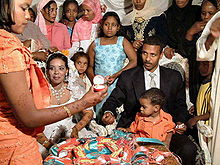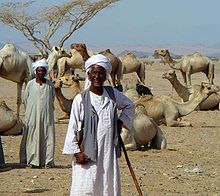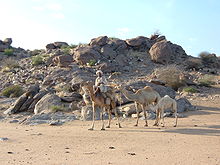- Demography of Sudan
-
 A Nubian wedding.
A Nubian wedding.
 Beja nomads in north.
Beja nomads in north.
 Meroe pyramids
Meroe pyramids
 Bedouin in north
Bedouin in north
This article is about the demographic features of the population of Sudan, including population density, ethnicity, education level, health of the populous, economic status, religious affiliations and other aspects of the population.
In Sudan's 1993 census, the population was calculated at 25 million. No comprehensive census has been carried out since that time due to the civil war. Estimates of Sudan, including the population of South Sudan, ranged from 37 million (United Nations estimate) to 45 million (CIA estimate). Since the secession of South Sudan in July 2011, estimates place the current population of Sudan at a little over 30 million.
The population of metropolitan Khartoum (including Khartoum, Omdurman, and Khartoum North) is growing rapidly and ranges from six to seven million, including around two million displaced persons from the southern war zone as well as western and eastern drought-affected areas.
Despite a predominate Arab culture and identity, Sudan has hundreds of ethnic and tribal divisions and language groups between them, which makes effective collaboration among them a major problem.[1][2][3]
Population Overview
Most Sudanese are Arabic-speaking Muslims, though the majority also use a traditional non-Arabic mother tongue (i.e., Nubian, Beja, Fur, Nuba, Ingessana, etc.). Among these are several distinct tribal groups; the Kababish of northern Kordofan, a camel-raising people; the Ja'Alin and Shaigiyya groups of settled tribes along the rivers; the seminomadic Baggara of Kordofan and Darfur; the Beja in the Red Sea area and Nubians of the northern Nile areas, some of whom have been resettled on the Atbara River; and the Nuba of southern Kordofan and Fur in the western reaches of the country.
Population Statistics
Achieving good counts of the population is difficult in Sudan, because conducting a census has been difficult due to various conflicts and wars in the southern, eastern and western regions of Sudan over the past few decades. The government of South Sudan (led by the former SPLM resistance movement) has in the past accused Sudan of deliberately manipulating the census in oil-rich regions such as the Abyei district, on the border between Sudan and South Sudan. The population count is a determining factor for the share of wealth and power each part of Sudan receives after the secession of South Sudan (See: Naivasha Agreement). Another complication is the Southern Sudanese refugees present in the north, whose citizenship in Sudan after the secession of South Sudan is now in question.[4]
CIA World Factbook demographic statistics
The following demographic statistics are from the CIA World Factbook, unless otherwise indicated. These statistics do not take into account the recent secession of South Sudan in July 2011 unless otherwise indicated, which would significantly reduce the population totals and affect other figures as well.
Population
45,047,502 (July 2011 est.; does not take into account the secession of South Sudan)
Age structure
0–14 years: 42.1% (male 9,696,726; female 9,286,894)
15–64 years: 55.2% (male 12,282,082; female 12,571,424)
65 years and over: 2.7% (male 613,817; female 596,559) (2011 est.; does not take into account the secession of South Sudan)Population growth rate
2.552% (2006 est.)
Birth rate
36.12 births/1,000 population (2011 est.)
Death rate
11 deaths/1,000 population (2011 est.)
Net migration rate
-0.29 migrant(s)/1,000 population (2011 est.)
Sex ratio
at birth: 1.05 male(s)/female
under 15 years: 1.04 male(s)/female
15–64 years: 1.01 male(s)/female
65 years and over: 1.05 male(s)/female
total population: 1.03 male(s)/female (2011 est.)Infant mortality rate
Total population: 68.07 deaths/1,000 live births Male: 68.77 deaths/1,000 live births Female: 67.34 deaths/1,000 live births (2011 est.)
Life expectancy at birth
total population: 55.42 years
male: 54.18 years
female: 56.71 years (2011 est.)Total fertility rate
- 4.93 children born/woman (2010 est.)
- 5.47 children born/woman (2000 est.)
Nationality
noun: Sudanese (singular and plural)
adjective: SudaneseEthnic groups
Main article: List of ethnic groups in Sudanblack 52% (rubric that includes numerous ethnic groups), Arab 39%, Beja 6%, foreigners 2%, other 1%
Religions
Sunni Muslim 97 percent (estimate after the secession of South Sudan). [5][6] Animist traditional beliefs and Christianity make up the remaining 3 percent.
Languages
Main article: Languages of SudanArabic (official), English (official), Nubian, Ta Bedawie
Literacy
definition: age 15 and over can read and write
total population: 61.1%
male: 71.8%
female: 50.5% (2003 est.)References
- ^ Askia Muhammad, Sudanese president answers questions on Darfur, The Final Call, May 14, 2007. Quote: "'Talk of Arabs killing Blacks is a lie,'” said Pres. Bashir in what may have been the first inter-active video conference between an African head of state with a Black group in this country. 'The government of Sudan is a government of Blacks, with all different ethnic backgrounds,' he continued. 'We’re all Africans. We’re all Black.'"
- ^ Darfur: Black vs Arab?, Arab Media Watch.
- ^ Mahmood Mamdani, The Politics of Naming: Genocide, Civil War, Insurgency, London Review of Books, Vol. 29, No. 5, March 8, 2007.
- ^ Broere, Kees. "Uitstel voor census Soedan". de Volkskrant, 15 April 2008, p. 5.
- ^ Country info: Sudan
- ^ Copts
 Sudan topics
Sudan topicsStates Al Jazirah · Al Qadarif · Blue Nile · Kassala · Khartoum · North Darfur · North Kurdufan · Northern · Red Sea · River Nile · Sennar · South Darfur · South Kurdufan · West Darfur · White NileHistory Demographic · Economic · Military
Timeline · Early · Coming of Islam · The Turkiyah · The Mahdiyah · Anglo-Egyptian rule · Independent Sudan · First Civil War · Nimeiri Era · Second Civil War · Transitional Military Council · Mahdi Coalition Governments · War in DarfurEconomy History · Transport · Communications · Companies · Merowe Dam · Sudanese pound · Sudanese dinar · Banks · TaxationPolitics · Military Constitution · President · Vice President · Prime Minister · Cabinet · Foreign relations · Sudanese Air ForceGeography
DemographicsGeology · Mountains · Lakes · Rivers · Volcanoes · Languages · Religion (Islam) · Social order · Ethnic groups · Education · Ethnic minorities · Human rights · Health · Refugees of Sudan · States · CitiesCulture Demographics of Africa Sovereign
states- Algeria
- Angola
- Benin
- Botswana
- Burkina Faso
- Burundi
- Cameroon
- Cape Verde
- Central African Republic
- Chad
- Comoros
- Democratic Republic of the Congo
- Republic of the Congo
- Côte d'Ivoire (Ivory Coast)
- Djibouti
- Egypt
- Equatorial Guinea
- Eritrea
- Ethiopia
- Gabon
- The Gambia
- Ghana
- Guinea
- Guinea-Bissau
- Kenya
- Lesotho
- Liberia
- Libya
- Madagascar
- Malawi
- Mali
- Mauritania
- Mauritius
- Morocco
- Mozambique
- Namibia
- Niger
- Nigeria
- Rwanda
- São Tomé and Príncipe
- Senegal
- Seychelles
- Sierra Leone
- Somalia
- South Africa
- South Sudan
- Sudan
- Swaziland
- Tanzania
- Togo
- Tunisia
- Uganda
- Zambia
- Zimbabwe
States with limited
recognition- Sahrawi Arab Democratic Republic
- Somaliland
Dependencies and
other territories- Canary Islands / Ceuta / Melilla / Plazas de soberanía (Spain)
- Madeira (Portugal)
- Mayotte / Réunion (France)
- Saint Helena / Ascension Island / Tristan da Cunha (United Kingdom)
- Western Sahara
Categories:- Demographics of Sudan
Wikimedia Foundation. 2010.


